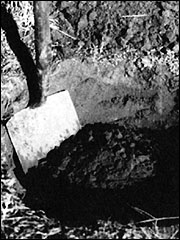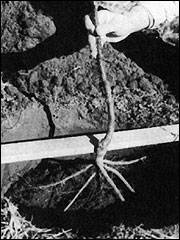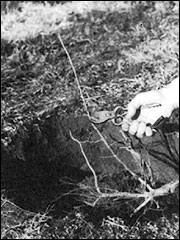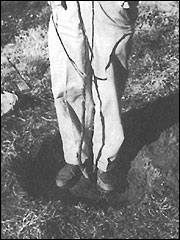The production of beautiful, blemish-free apples in a backyard setting is challenging in the Midwest. Temperature extremes, high humidity, and intense insect and disease pressure make it difficult to produce perfect fruit like that purchased in a grocery store. However, careful planning in selecting the apple cultivar and rootstock, locating and preparing the site for planting, and establishing a season-long routine for pruning, fertilizing, watering, and spraying will greatly enhance the flavor and appearance of apples grown at home.
How many to plant?
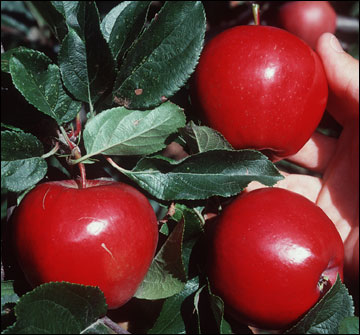 In most cases, the fruit produced from two apple trees will be more than sufficient to supply a family of four. In most cases, two different apple cultivars are needed to ensure adequate pollination. Alternatively, a crabapple tree may be used to pollinate an apple tree. A mature dwarf apple tree will generally produce 3 to 6 bushels of fruit. One bushel is equal to 42 pounds. A semidwarf tree will produce 6 to 10 bushels of apples. After harvest, it is difficult to store a large quantity of fruit in a home refrigerator. Most apple cultivars will quickly deteriorate without adequate cold storage below 40 degrees Fahrenheit.
In most cases, the fruit produced from two apple trees will be more than sufficient to supply a family of four. In most cases, two different apple cultivars are needed to ensure adequate pollination. Alternatively, a crabapple tree may be used to pollinate an apple tree. A mature dwarf apple tree will generally produce 3 to 6 bushels of fruit. One bushel is equal to 42 pounds. A semidwarf tree will produce 6 to 10 bushels of apples. After harvest, it is difficult to store a large quantity of fruit in a home refrigerator. Most apple cultivars will quickly deteriorate without adequate cold storage below 40 degrees Fahrenheit.
What cultivar or rootstock to plant?
Apple trees generally consist of two parts, the scion and the rootstock. The scion cultivar determines the type of apple and the fruiting habit of the tree. The rootstock determines the earliness to bear fruit, the overall size of the tree, and its longevity. Both the scion and rootstock affect the disease susceptibility and the cold hardiness of the tree. Thus, careful selection of both the cultivar and the rootstock will contribute to the fruit quality over the life of the tree.
Because Missouri's climate is favorable for fire blight, powdery mildew, scab, and cedar apple rust, disease-resistant cultivars are recommended to minimize the need for spraying fungicides. MU publication G6026, Disease-Resistant Apple Cultivars, lists attributes of several cultivars. Popular midwestern cultivars such as Jonathan and Gala are extremely susceptible to fire blight and thus are difficult to grow because they require diligent spraying. Liberty is a high-quality tart apple that is resistant to the four major diseases and can be successfully grown in Missouri.
Other popular cultivars, such as Fuji, Arkansas Black, Rome, Red Delicious and Golden Delicious can be successfully grown in Missouri. Honeycrisp does not perform well under warm summer conditions and is not recommended for planting. Some cultivars are available as spur- or nonspur-types. A spur-type cultivar will have a compact growth habit of the tree canopy, while a nonspur-type produces a more open, spreading tree canopy. Because spur-type cultivars are nonvigorous, they should not be used in combination with a very dwarfing rootstock (M.9 or G.16). Over time, a spur-type cultivar on M.9, Bud.9, G.11, G.41 or G.16 will "runt-out" and produce a small crop of apples. Nonspur-type cultivars grafted onto a dwarfing rootstock should produce a consistent load of apples each season over the life of the tree.
Apple trees on dwarfing rootstocks are recommended to facilitate training, pruning, spraying and harvesting. Trees on dwarfing rootstocks also start producing fruit the second season after planting and generally have a life span of about 20 years. A dwarf tree can still be 15 feet tall when grown in Missouri. When purchasing a tree from a nursery, often the consumer does not get to choose the rootstock that induces the dwarfing habit of the trees. However, when it is possible to select the rootstock, those listed above are recommended. M.9 rootstock is susceptible to fire blight when environmental conditions are favorable for the disease and can be injured by freezing temperatures in early fall before the tree is acclimated to cold weather. Apple trees on semidwarf rootstocks such as EMLA.7, M.7A or G.30 are large trees (up to 20 feet tall) at maturity. Trees on semidwarf rootstocks generally begin to produce fruit four years after planting and continue to bear for 25 years. Trees on M.7A rootstock are vigorous, but produce several rootstock suckers, which should be pruned annually. In Missouri, M.26 rootstock should be avoided because of its susceptibility to fire blight. Another problematic rootstock is MM.106, which is susceptible to crown rot disease during rainy seasons.
Planting
- When to plant
Apples should be planted in late March or before April 15 when the soil is thawed and air temperatures are cool. Apple trees purchased in containers can be planted in mid- to late October. While fall is a good time to plant fruit trees, bare root trees are not usually available from nurseries at this time. - Where to plant
Apple trees should be planted where they receive full sun (at least six or more hours) and where the soil is reasonably deep and fertile with good water drainage. If the soil has poor drainage, tiles should be placed in the soil or the tree can be planted on an 8-inch berm. Because many Missouri soils are deficient in phosphorus, a soil test should be taken before planting. If needed, phosphorus should be incorporated into the planting hole before setting the tree. Application of phosphorus after planting is ineffective because it is an immobile nutrient and cannot be easily leached into the root zone without disturbing tree roots. - Preparation for planting
Never expose tree roots to sun or drying winds so that they become dry before planting. After receiving trees, unwrap the package and make sure the roots are moist. Keep roots packed in moist peat moss, sawdust, or strips of newspaper until ready to plant. Keep the roots cool (but above freezing). Try to plant trees soon after they are received. Trees held for longer than a few days may bud out and can be susceptible to breakage. About an hour before planting, soak tree roots in a bucket of water to ensure that they are hydrated. - How to plant
Dig a hole about 2 feet wider than the spread of the tree roots and deep enough to prevent crowding. The tree should be planted at the same depth as it was in the nursery (Figures 1 and 2). Always keep the graft union 2 inches above the final soil line. - Before planting the tree, inspect the root system
Prune broken roots and shorten long roots to 12 to 18 inches (Figure 3). Use sharp pruning shears. Place the tree in the hole and arrange the roots so they aren't overlapping. If they appear cramped, make the hole larger! Refill the hole with the same soil that was removed from the hole. Refilling the hole with other materials will create an undesirable situation. To avoid air pockets, tamp the soil with your foot as the hole is filled (Figure 4). After the soil has been firmly tamped, slowly apply 1 or 2 gallons of water to the tree. This will hydrate the tree and help settle the soil around the roots. Add additional soil if needed to maintain the soil at the same level as that surrounding the hole (unless planting on a berm). If the graft union of the tree sinks into the soil, reposition it so it remains 2 inches above the soil level. When the graft union becomes covered with soil, the scion cultivar will root and the dwarfing habit induced by the rootstock will be lost. - Rodent guard
After planting, a 15- to 18-inch piece of hardware cloth should be placed around the trunk of the tree to prevent rabbit, mice, or vole damage. It should be placed about four inches into the soil. As the tree becomes older, do not permit the hardware cloth to girdle the trunks. White plastic spiral tree guards should be avoided as they can provide a habitat for insect pests that may damage the tree. 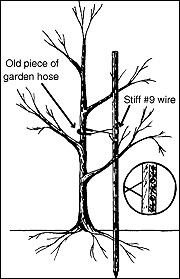 Staking
Staking
A stake should be placed beside an apple tree to provide support. A 2 x 2-inch stake is generally sufficient. For trees on dwarfing rootstocks, the stake should be 10 feet tall and will remain in the ground for the life of the tree. Small trees can be easily overloaded with apples and will lean or break because of their weaker root system. Stakes for trees on EMLA.7, M.7A and G.30 (semidwarfing) rootstocks should be 6 to 8 feet tall. Stakes on these trees are needed only in the first five years after planting to support the main trunk. After this time, the root system and the framework of the tree are generally strong enough to support the tree with fruit on it. After selecting a stake, drive it 2 feet into the soil. Secure the tree to the stake by a heavy number 9 wire and a section of an old garden hose or some other material to prevent scraping off the bark when the tree moves in the wind- Training and pruning trees
Beginning at planting, it is important to develop a strong tree framework before allowing it to bear fruit.
Fertilizing trees
One month after spring planting, apply about a half pound of 12-12-12 (or similar analysis) fertilizer per tree in a circular band around the edge of the original planting hole. The year after planting, apply about one pound of 12-12-12 fertilizer per tree in a circular band under the drip line of the tree canopy just before growth begins in the spring. In subsequent years, fertilizer needs will probably increase; the amount of fertilizer to apply can be gauged by the terminal growth on branches made the preceding year. Young trees (one to six years old) should have 12 to 18 inches of new shoot growth each year and 6 to 12 inches of growth thereafter. Growth above or below these figures would indicate too much or too little fertilizer. After inspecting the amount of terminal growth, the amount of fertilizer can be adjusted from the amount applied the previous year. In a year when the blossoms are injured by frost and the crop is lost, do not apply any fertilizer because it will promote too much vegetative growth.
Other cultural practices
- Early flowering and fruiting
Remove all flowers and apples from young trees during the first two growing seasons. During this time it is important to develop a strong framework for the tree to support the crop in later years. Cropping the tree during the first two years of establishment can stunt it. In the third year, fruit can be left on the scaffold branches but should be removed from the central leader. Beginning in the fourth year, the central leader and scaffold branches can be cropped, but fruit should be selectively thinned. - Fruit thinning
During a heavy bloom season, apples commonly set too many fruits. Remove all excess fruits during the first week of June. This is after the time of the last natural drop. In thinning, leave only one apple per cluster and space the apples not closer than 6 inches apart. This may remove more than three-fourths of the apples on the tree. Although this practice may seem drastic, it is essential for- Good-sized apples at harvest
- Development of fruit buds for next year's crop. When thinning, leave the largest apple in the cluster unless it is damaged in some way. With just a few trees, fruit removal can be done by hand in a few hours.
- Pest control
Apples have many persistent pests. Pests may be controlled through good cultural practices and when necessary chemical control.
Good cultural practices
- Plant on a well-drained site; berms or tile drainage should improve a poorly drained site.
- Fertilize properly; excessive, vigorous growth or weak growth is disease-prone.
- Prune and train properly; sunlight penetration and air movement withing the canopy are essential for quick drying of the tree foliage, which will help prevent disease infections.
- Prune and remove any diseased or insect-infested fruit or branches. For instance, fire blight is commonly controlled by cutting out branches 6 to 8 inches below the diseased wood early in the growing season, and apple scab can often be controlled by raking up and destroying diseased leaves in the fall.
- Control weeds properly. Weeds compete with the plant for moisture and nutrients and harbor many other pests; use herbicides, a weed barrier type of mulch, or shallow cultivation to reduce weed competition.
Plant disease-resistant cultivars when possible
When cultural control of pests is ineffective or impractical, chemicals often are needed to control the pests. To control pests chemically,
- Use effective chemicals, but those considered safe for the homeowner to apply
- Apply proper dosages
- Time sprays properly
- Obtain thorough coverage of all plant parts. Failure to properly execute any of these steps can result in inadequate control of insects or unsuccessful prevention of foliage diseases.
By the third year (fruiting year) after planting, obtain an adequate sprayer of some kind. A compressed air sprayer or knapsack sprayer is adequate for a limited number of dwarf trees.
